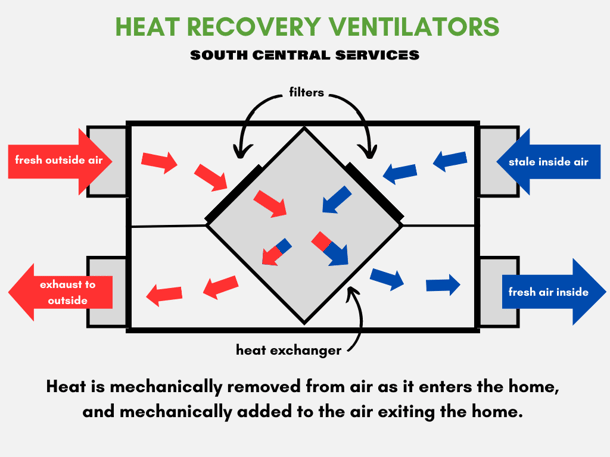The Comprehensive Guide to HRV Setup in Residential Spaces
Wiki Article
Exploring the Benefits of Heat Recovery Ventilation for Energy Effectiveness in Residences
Heat Recovery Ventilation (HRV) systems offer house owners a useful method to enhancing energy performance. By reclaiming heat from outgoing air, these systems can substantially decrease heating & cooling costs. Additionally, they offer a constant supply of fresh air, boosting interior air top quality and convenience levels. As property owners take into consideration lasting alternatives, comprehending the nuances of HRV systems ends up being progressively vital. What variables should one review prior to making such a financial investment?Comprehending Heat Recovery Ventilation Equipments

Exactly How HRV Boosts Indoor Air Quality

Energy Cost Savings: The Monetary Benefits of HRV
Taking full advantage of energy effectiveness, heat recovery ventilation (HRV) systems provide significant financial benefits for homeowners. By recovering and recycling warmth from exhaust air, HRVs noticeably minimize cooling and heating expenses. HRV Heat Recovery Ventilation This innovation can cause energy savings of up to 30%, relying on environment and usage patterns. Home owners frequently notice lowered energy expenses shortly after installation, making HRVs a financially sensible financial investment with time. In addition, lots of regions provide rewards or refunds for energy-efficient upgrades, better boosting the economic allure. As energy costs remain to increase, the cost-effectiveness of HRVs comes to be significantly clear. Overall, the incorporation of HRV systems not just promotes power performance yet likewise contributes to long-lasting economic cost savings for homes.The Ecological Effect of Heat Recovery Ventilation
A significant ecological benefit of heat recovery ventilation (HRV) systems depends on their ability to minimize general power consumption. By redeeming warmth from exhaust air and moving it to incoming fresh air, HRV systems lessen the need for energy-intensive heating and cooling down techniques. This reduction in power demand adds to reduce greenhouse gas exhausts, as much less nonrenewable fuel source is needed to keep comfy indoor temperature levels. Furthermore, HRV systems enhance indoor air top quality by efficiently trading stale air with fresh outside air, lowering reliance on mechanical cooling systems that can damage the environment. Generally, the application of HRV systems supports sustainable living methods and straightens with international initiatives to deal with climate change by advertising power effectiveness in domestic settings.
Choosing the Right HRV System for Your Home
Just how can homeowners assure they pick the ideal heat recovery ventilation (HRV) system for their requirements? They should examine their home's size and design, as these elements influence air flow needs. Next off, examining the system's effectiveness ratings is essential, as greater scores indicate far better efficiency and energy savings. Property owners ought to also take into consideration setup and maintenance costs, comparing different brands and designs for worth. Furthermore, it is necessary to examine noise degrees, as some systems run more silently than others. Consulting with cooling and heating experts can provide customized recommendations based upon certain home conditions. Finally, examining user testimonials and warranties can assist in making an educated decision, making sure that the picked HRV system efficiently enhances interior air quality and energy efficiency.Often Asked Questions

Just how Commonly Should I Clean or Keep My HRV System?
The frequency of cleansing or keeping a warm healing air flow (HRV) system generally relies on usage and ecological aspects. Generally, it is advisable to perform maintenance every six months to ensure peak efficiency and air high quality.
Can HRV Solutions Help In Reducing Moisture Degrees Inside Your Home?
HRV systems can efficiently decrease indoor humidity levels by trading stagnant, moist air with fresh, drier air from outdoors. HRV Heat Recovery Ventilation. This process assists preserve a well balanced interior atmosphere, boosting convenience and preventing moisture-related problems
What Is the Life expectancy of a Regular HRV System?
The life expectancy of a common heat recovery ventilation (HRV) system differs, normally lasting in between 10 to 15 years. Routine upkeep can extend its effectiveness and operational life, making certain peak efficiency throughout its usage duration.Are There Any Sound Worry About HRV Equipments?
Sound interest in HRV systems can develop, especially from follower operation. Many contemporary units are made to minimize audio levels, ensuring they run quietly while preserving effectiveness, which resolves possible disturbances in living atmospheres.Can I Mount an HRV System Myself, or Do I Required a Professional?
The private contemplated whether to mount the heat recovery ventilation (HRV) system directly or employ an expert. Typically, while DIY installment is feasible, expertise warranties appropriate capability and conformity with regional building ordinance, enhancing system effectiveness.Report this wiki page